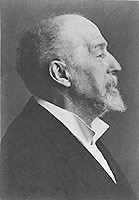
Otto Koloman Wagner was an Austrian architect, furniture designer and urban planner. He was a leading member of the Vienna Secession movement of architecture, founded in 1897, and the broader Art Nouveau movement. Many of his works are found in his native city of Vienna, and illustrate the rapid evolution of architecture during the period. His early works were inspired by classical architecture. By mid-1890s, he had already designed several buildings in what became known as the Vienna Secession style. Beginning in 1898, with his designs of Vienna Metro stations, his style became floral and Art Nouveau, with decoration by Koloman Moser. His later works, 1906 until his death in 1918, had geometric forms and minimal ornament, clearly expressing their function. They are considered predecessors to modern architecture.

Synagogue architecture often follows styles in vogue at the place and time of construction. There is no set blueprint for synagogues and the architectural shapes and interior designs of synagogues vary greatly. According to tradition, the Shekhinah or divine presence can be found wherever there is a minyan, a quorum, of ten. A synagogue always contains an Torah ark where the Torah scrolls are kept, called the aron qodesh by Ashkenazi Jews and the hekhal by Sephardic Jews.
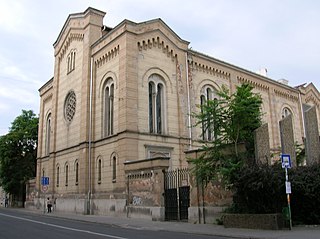
The Kazinczy Street Synagogue of Miskolc is the only surviving synagogue in the city of Miskolc, Hungary, and the only still functioning synagogue of Borsod-Abaúj-Zemplén county.

The Dohány Street Synagogue, also known as the Great Synagogue or Tabakgasse Synagogue, is a historical building in Erzsébetváros, the 7th district of Budapest, Hungary. It is the largest synagogue in Europe, seating 3,000 people and is a centre of Neolog Judaism.
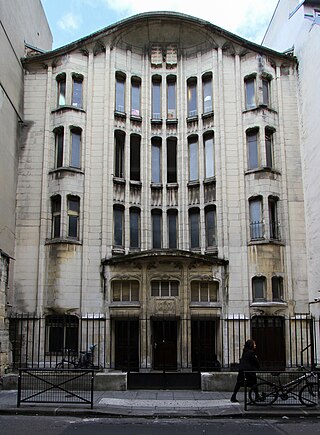
The Agoudas Hakehilos Synagogue, at 10 rue Pavée, in the 4th arrondissement of Paris, commonly referred to at the Pavée synagogue, rue Pavée synagogue, or Guimard synagogue, was designed by Art Nouveau architect Hector Guimard and erected between 1913 and 1914.
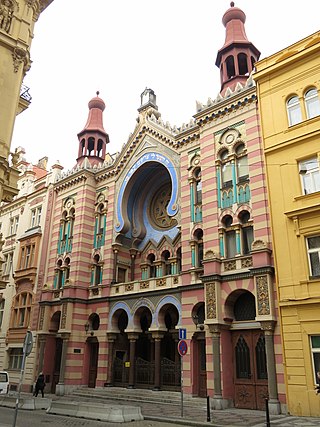
Jubilee Synagogue, also known as the Jerusalem Synagogue for its location on Jerusalem Street, is an active synagogue in Prague, Czech Republic. It was built in 1906, designed by Wilhelm Stiassny and named in honor of the silver Jubilee of Emperor Franz Joseph I of Austria. Although originally built as a "reform" synagogue, it is nowadays used by the more traditional members of the Prague Jewish community, aligning itself officially with orthodox Judaism. Still, compared to the famous other active synagogue of Prague, the Old-New Synagogue, the Jubilee Synagogue is far less stringent in many ways.
The architecture of Hungary is understood as the architecture of the territory of the country of Hungary, and in a wider, of the Kingdom of Hungary, from the conquest to the present day.

TheGreat Synagogue is an Orthodox Jewish congregation located in a large heritage-listed synagogue at 187a Elizabeth Street in the Sydney central business district in the City of Sydney in New South Wales, Australia.
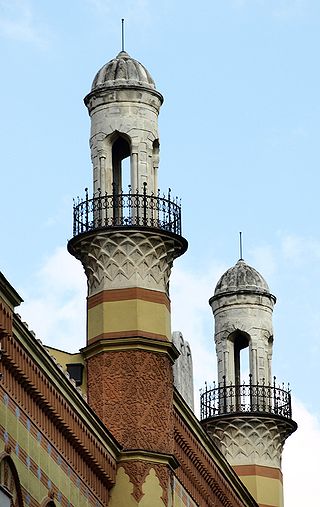
The Rumbach Street synagogue is located in Belváros, the inner city of the historical old town of Pest, in the eastern section of Budapest. The synagogue in Rumbach Street was built in 1872 to the design of the Viennese architect Otto Wagner. Intentionally meant to serve the members of the Neológ community of Pest, its construction coincided with the Schism in Hungarian Jewry of 1869, and it became the home of the more conservative Status Quo faction.
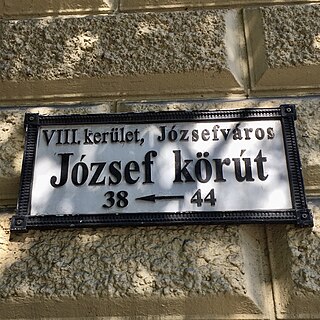
Budapest's Palotanegyed forms an inner part of Pest, the eastern half of Budapest. Known until the communist period as the ‘Magnates’ Quarter’, it consists of the western part of the city's Eighth District, or Józsefváros, which was named on 7 November 1777 after Joseph II, Holy Roman Emperor and Archduke of Austria (1741-1790), who reigned 1765-1790. . Józsefváros developed immediately east of the medieval walls of Pest and was originally called Lerchenfeld or the Alsó-Külváros. The Palotanegyed's borders are the Múzeum körút to the west, Rákóczi út to the north, the József körút to the east and Üllői út to the south. There is an extensive photo archive of the Palace District at the Fortepan website.

Anshei Minsk is a synagogue in the Kensington Market neighbourhood of Toronto, Ontario, Canada. It was founded in 1912 by poor Jewish immigrants from what is now Belarus, which at the time was part of the Russian Empire. The current Byzantine Revival building was completed in 1930.

Cetate Synagogue is a Jewish place of worship in Timișoara, located on Mărășești Street in the Cetate district. It was built between 1863 and 1865 in an eclectic style with Moorish elements. It is inscribed in the list of historical monuments in Timiș County. The synagogue reopened for the public in 2022.
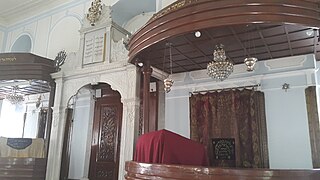
The Signora Giveret Synagogue is an Orthodox Jewish synagogue in the city of Izmir, Turkey. The synagogue dates back to the 16th century and is still in use today.

The residential building of number 37, Népszínház street, is located in the 8th district of Budapest, Hungary, on the odd side of the street between Nagyfuvaros and Kisfuvaros street.

Kordeckiego street is located in downtown district of Bydgoszcz, Poland. It has been laid in the 1850s. Many frontages on this street offer architectural interests: some of the buildings are registered on the Kuyavian-Pomeranian Voivodeship Heritage List.
Art Nouveau temples are churches, chapels, synagogues, and mosques built in the style known as Art Nouveau in French and English languages, Jugendstil in Germany and Nordic countries, Secessionsstil in countries of former Austro-Hungary, Modernisme in Catalan, Modern in Russian, Stile Liberty or Stile Floreale in Italian. As National Romantic style is also referred to Art Nouveau, churches of that style are also listed here, as well as some temples not of pure Art Nouveau style but with distinctive Art Nouveau features.
The architecture of Slovakia has a long, rich and diverse history. Besides Roman ruins, Slovakia hosts several Romanesque and Gothic castles and churches, most notably Spiš Castle, which were built at the time of the Kingdom of Hungary. Renaissance architecture was of particular relevance in town hall squares, such as in Bardejov and Levoča. Affluent architecture in the following centuries made use of Baroque, Rococo and historicist styles, while vernacular architecture in the countryside developed a specific style of wooden houses and wooden churches. In the 20th century, Slovakia knew Art Nouveau and modernist architecture, including socialist modernism, and finally contemporary architecture.
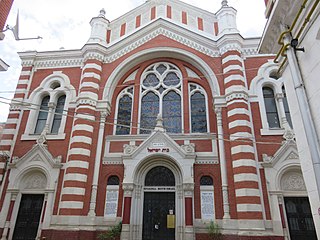
The Beth Israel Synagogue in Brasov, stands at 29 Poarta Șchei Street in the center of Brasov, Romania, behind the street front, on a plot surrounded by houses. The synagogue still plays a ritual role. The building complex includes a community seat and a kosher restaurant. Beth Israel Synagogue is included in the list of National Historic monuments in Romania under the number BV-II-m-B-11515.

Géza Márkus was a Hungarian Jewish architect.

Dohány utca is a street in the Erzsébetváros, the 7th district of Budapest, Hungary. It runs between Karoly kórüt and Rottenbiller utca, roughly parallel to Rákóczi út and Wesselenyi utca, and is about 1.6 kilometers in length. It contains many of Budapest's significant buildings along its length, including the famed Dohány Street Synagogue at its western end.























